The 2024 AMOS Conference, September 17-20, celebrated 25 years at the Wailea Beach Resort, Maui. Presented by Maui Economic Development Board (MEDB), the premier technical conference in the nation devoted to Space Domain Awareness hosted 1101 in-person attendees with a further 231 participating virtually.
“For a quarter century the AMOS Conference has been at the forefront of technical exchange in space situational awareness” said Leslie Wilkins, MEDB President and CEO, in her welcome remarks. “AMOS brings together a diverse audience to bridge technical gaps, foster international cooperation, and advance space sustainability. With over half of the audience in the private sector, the trend remains reflective of the continuing commercialization of space and related technologies.”
The opening segment of the conference began with a traditional Hawaiian invocation with a reflection and sense of place to set the tone for the week. The message provided guidance and a reminder of responsibility as stewards of the land. Learn more about Healeakala: Sense of Place.
The morning program also included a look back at the origins of the AMOS Conference with a presentation by Paul Kervin, founding conference technical chair. Maui has some of the most diverse and highly capable optical telescopes (AEOS, Pan-STARRS), instrumentation (adaptive optics, spectrometers, photometers, radiometers) and processing capabilities (MHPCC) centralized into one location on the planet Earth and in 1999 the technical conference was initiated by the AFRL aimed at users of these facilities. Kervin took the audience through the evolution of technology and topics, the growth in audience in numbers and types.
The annual AMOS Conference program featured daily keynote speakers, SSA/SDA policy forums, featured presentations, technical oral and poster sessions, exhibits, short courses and networking receptions. Both in-person and livestream attendees had access to a virtual platform to facilitate networking and collaboration before, during and after the conference.
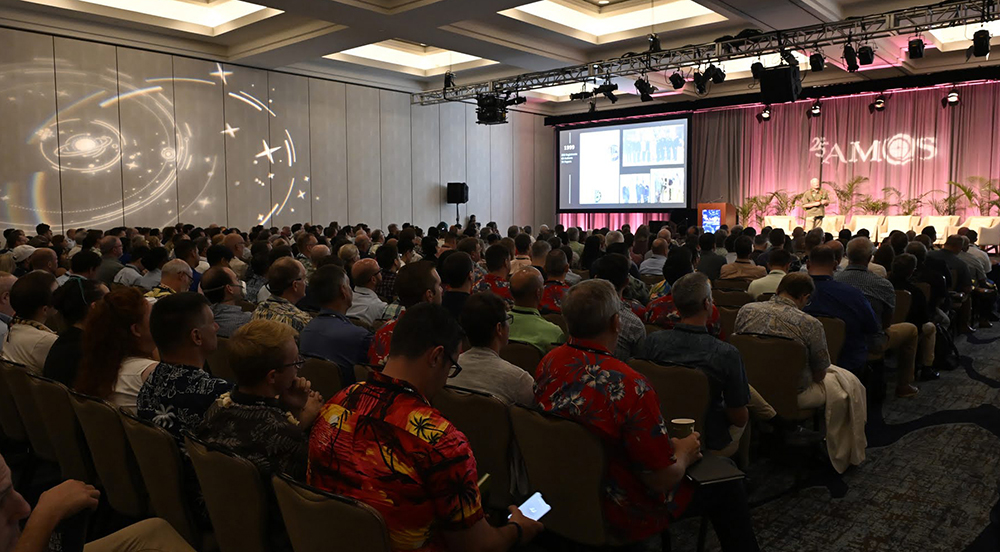
Technical Conference
The Call for Papers closed March 1 and received over 300 abstracts from 27 countries with 152 papers presented as oral or poster presentation. Technical sessions this year covered the topics of Astrodynamics; Atmospherics/Space Weather; Cislunar SSA; Conjunction/RPO; Machine Learning for SSA Applications; Satellite Characterization; SDA Systems & Instrumentation; Space-Based Assets; Space Debris; and Space Domain Awareness.
“It’s the best venue for presenting the research and development and technology that I have developed with my team over the years for space surveillance and space domain awareness,” said Tamara Payne, Technical Subcommittee Chair of the American Astronautical Society (AAS) Space Surveillance Committee. Speaking to a sense of place, she added, “Space domain awareness is becoming more and more international and it’s more of an allied and international partner effort, which is a good thing because space is global. And we need a global cooperative arrangement so that we can take care of space and monitor the environment and shepherd and be good stewards of our Earth and our space around it.”
Attendees had access to all technical posters through the virtual platform with 88 posters presented in digital format with accompanying briefings. 44 of these posters were presented in-person in the AMOS Exhibit Venue during the evening Poster Sessions.
Awards and Journal Publication
Select papers are invited for a peer-review process for publication in the 2024 Journal of Astronautical Sciences, and on the last day of the conference the American Astronautical Society (AAS) recognized outstanding efforts by presenting awards.
Best Paper for 2024 AMOS Conference was awarded to Sam Wishnek, BAE Systems for Minimum Observation Methods of Initial Maneuver Determination. Ethan Foss, University California, San Diego won the Best Student Paper Award for Reachability Analysis of Low-Thrust Cislunar Spacecraft Using State Transition Tensors.
Four awards were presented for Poster presentations. The Golden Ticket Award was won by Brian Williams, Slingshot Aerospace for ML-Based Photometric Fingerprinting and Event Detection at Scale for LEO Satellite Monitoring. This award goes to the best overall poster—a poster so good that it wins a guaranteed oral presentation slot for AMOS 2025.
Most Creative poster is awarded to the poster with the most ambitious goal and/or most unexpected methodology to solve—this year it was presented to Fabio Chiappina, a.i. solutions for Autonomous Trajectory Planning for Cislunar Space.
Chiappina shared, “I think the poster session has been probably the highlight for me…getting to get into the nitty gritty with the people who are interested is really fascinating and that’s where I’ve gotten a lot of my best feedback. They have given me new perspectives that I never would have thought of and some of the comments have been so interesting that I sat there and thought why didn’t I think of that myself that’s such a good idea.”
Rachel Stutz, Orion Space Solutions won the Newcomer Award as top poster presenting at AMOS for the first time. Her paper is Dragster 2.0: An Operations-Ready Framework for Neutral Density Assimilation.
Poster Session Chairs Matthew Stevenson, LeoLabs; and Pat Patterson, Space Dynamics Laboratory, hosted the Lightning Pitch Presentations. The in-person poster presenters were given the opportunity on the side-stage in the Exhibit Venue to give a 30-second pitch to encourage listeners to come view and hear more about their posters. Stevenson and Patterson were joined by Valerie Skarupa of DarkStar Space to judge and award the Best Poster Lightening Pitch. The award was presented to Di Wu, MIT for his poster MOCAT on Temporal Analysis and Quantification for Policies in Space Sustainability.
Keynotes and Policy Forums
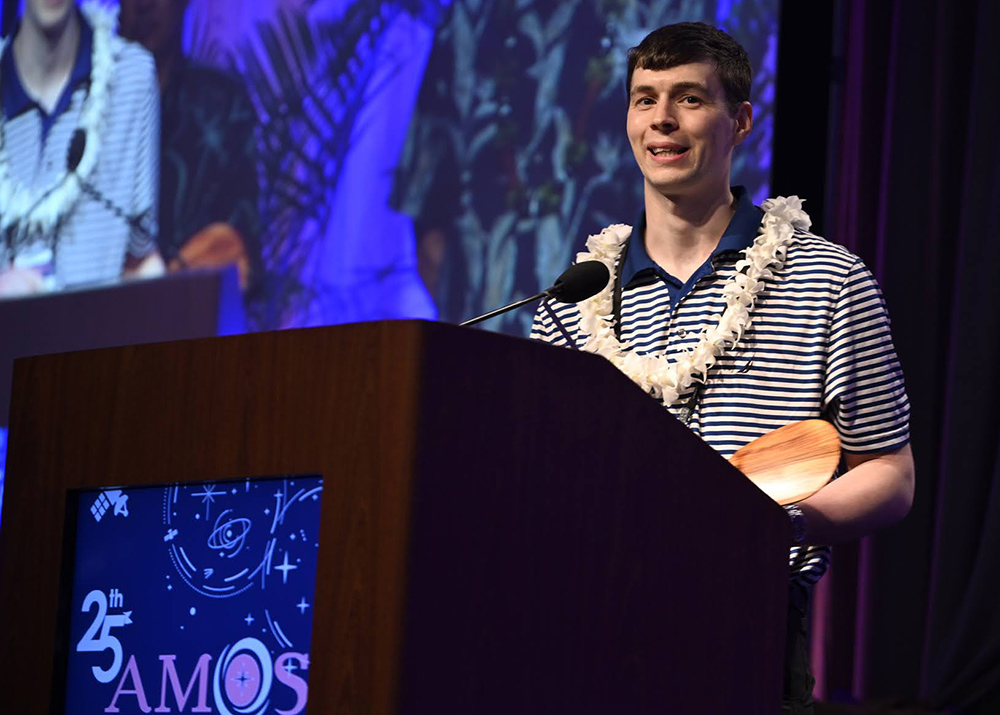
2024 Best Paper Award Winner – Sam Wishnek, BAE Systems
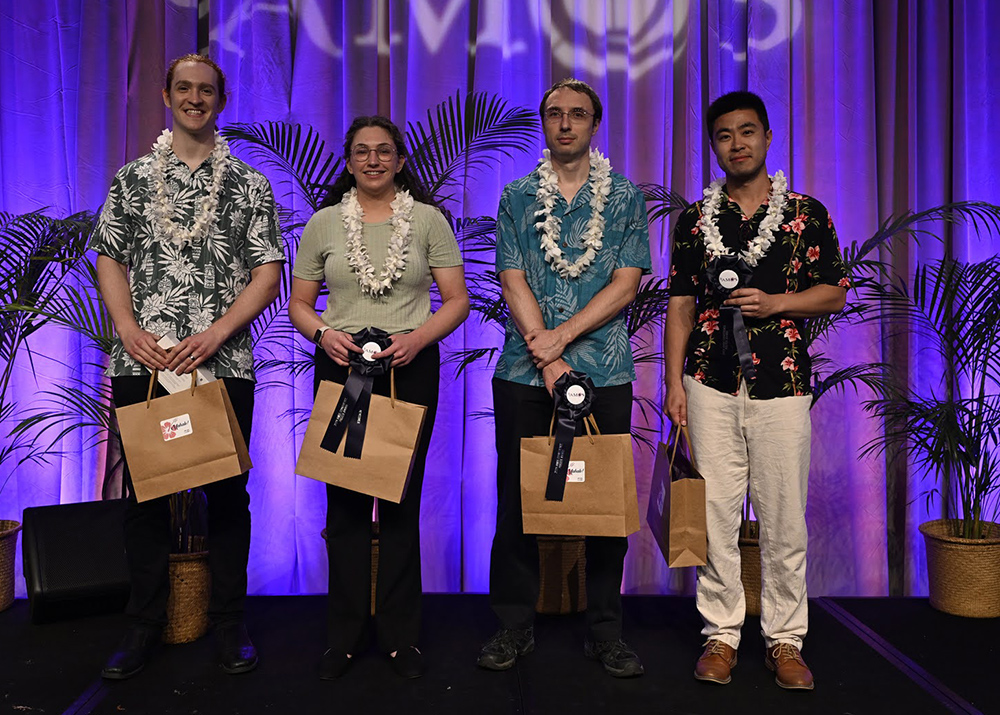
Poster prize winners from L to R: Fabio Chiappina, a.i. solutions; Rachel Stutz, Orion Space Solutions; Brian Williams, Slingshot Aerospace; Di Wu, MIT.
Day 1
Lieutenant General Philip A. Garrant, Commander of Space Systems Command (SSC), headquartered at Los Angeles Air Force Base, gave the opening Keynote. He pointed out, “The SSC recognizes that our partnerships with industry and our allies enable us to deliver capability more rapidly to the joint force. AMOS provides the platform for the SDA community to build these partnerships and have purposeful exchanges driving towards ground-breaking solutions. So as you connect, and work and partner this week, please engage in discussion, learn from each other and let’s get after those problems.”
Asked about the increasing role of commercial actors in the space domain, Garrant replied, “Just like our allied partners, we need commercial to help us too. They have access to orbital regimes that we’re not in. They have rapidly developing capabilities that we need to take advantage of. And quite frankly, entangling commercial and ally partners into our space architecture complicates the calculus for the adversaries and makes them think twice about that.”
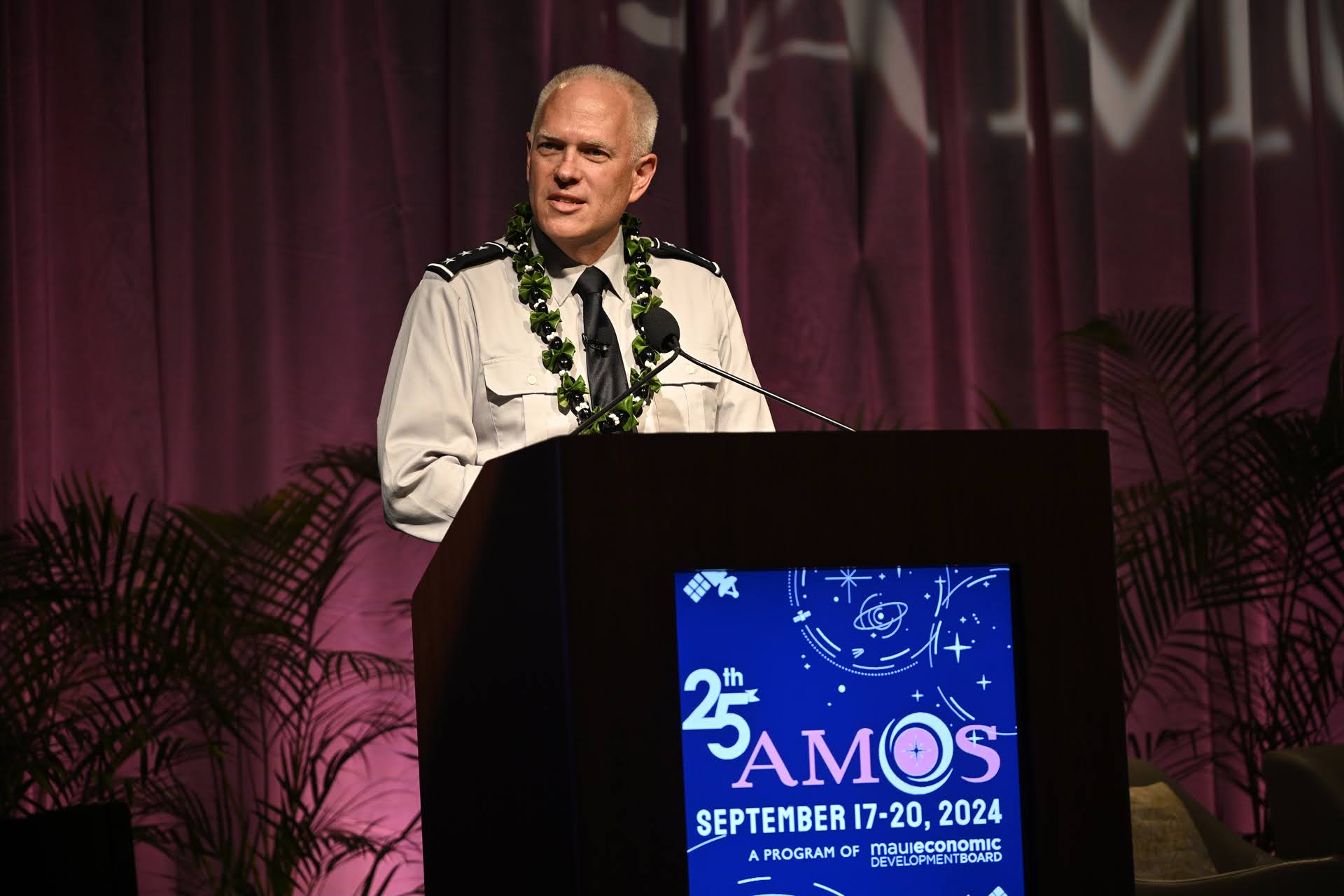
Lieutenant General Philip A. Garrant, Commander of Space Systems Command (SSC), headquartered at Los Angeles Air Force Base, gave the opening keynote at AMOS 2024
Ian Christensen, Senior Director, Private Sector Programs, Secure World Foundation led the SSA Policy Forum on Day 1 titled Sustainable Operations in the Space Environment: The Role of Orbital Carrying Capacity and Other Tools. “I think we have a good mix on this panel to look at things from a modeling perspective and to look at things from a policy and governance standpoint,” said Christensen, introducing his panel. “The overall question that we want to look at is what is the potential need for approaching management of the space environment in a more holistic manner? What is the need for that and what tools do we have for that?
On the panel were Erik Babcock, Director of Starlink Guidance, Navigation, and Control, SpaceX; Richard Linares, Associate Professor, Department of Aeronautics and Astronautics, Massachusetts Institute of Technology; Andrea Muciaccia, Poletecnico di Milano; Andrew Ratcliffe, Chief Engineer, United Kingdom Space Agency and Audrey Schaffer, Vice President, Policy and Strategy, Slingshot Aerospace.

L to R. Ian Christenson, Secure World Foundation; Erik Babcock, SpaceX; Andrew Ratcliffe, United Kingdom Space Agency; Audrey Schaffer, Slingshot Aerospace; Andrea Muciaccia, Poletecnico di Milano; Richard Linares, Associate Professor, Massachusetts Institute of Technology.
Audrey Schaffer set the tone of the panel with some statistics from Slingshot Aerospace database that curates open source information on every object that has ever launched into space. “In 2009, which is the first year I looked at, because that was the year of the Iridium Cosmos collision, there were just under a thousand active satellites in all of space, of which about 400 of them were in low Earth orbit. Fast forward five years to 2014, which I think was the first year I came to AMOS, there were 1,200 active satellites in all of space, and about half of them, 600, were in low-earth orbit. Five years later, 2019, the total number was 2,000 and the number in LEO was 1,300. Now in 2024, there are over 10,000 active satellites in all of space, and 9,500 of them are in low-earth orbit; by the way, about 8,200 of those are commercial satellites. About half of those satellites are within roughly about 500 to 600 kilometers altitude. That’s a pretty dramatic change in the last 15 years, just purely in terms of numbers of objects.”
“The other interesting statistic I wanted to offer,” Schaffer continued. “It’s the average separation distance between objects in GEO. In 2014, that average distance was 350 kilometers. Now ten years later, it’s 250 kilometers. So, in addition to just the sheer number of objects rising, we’re also seeing closer operations, more dynamic operations, more complex operations, that I think are really very dramatically changing just the context in which all of these space activities happen.”
Erik Babcock talked about the key needs to support sustainable operations of a constellation, “I think what we need from the space surveillance environment is quite simple and it is to minimize latency. Today’s industry standard latency, meaning time from observation of an object to association of that object in the catalog to updated or determination, screening and finally issuance of the (Conjunction Data Message) takes hours. Generously let’s call it eight hours. It’s 2024, why are we measuring that in hours and not minutes or even seconds? And then on the operator side, I think it’s quite uncommon to find an operator who will actually take action on a CDM with less than a day or two, time until closest approach.”
“On Starlink, we developed a low latency screening service that we invite other operators to participate in. We are working with the Office of Space Commerce to deploy this system to TraCSS since we believe so strongly that the industry needs to move to a lower latency.”
Day 2
Day 2 kicked off with a keynote presentation by Dr. Hiroshi Yamakawa, President, Japan Aerospace Exploration Agency (JAXA). Yamakawa gave an overview of Japan’s space activities.
“JAXA started as a R&D space agency,” said Yamakawa. “But as you know, JAXA is developing, launching, and operating rockets and satellites. So we are also defined as implementation agencies. Implementation means that we are actually doing something in space. And just recently, the government defined JAXA as the funding agency. So we have now three roles, R&D, implementation, and funding. JAXA has been engaging in every aspect of space, including SSA.”
After his presentation, Yamakawa shared, “This is my third or fourth AMOS conference, and I’m very glad to be back. I think AMOS is one of the most important forums for international SSA communities…especially when we talk with our friends from all over the world, SSA will be going to the next phase.”
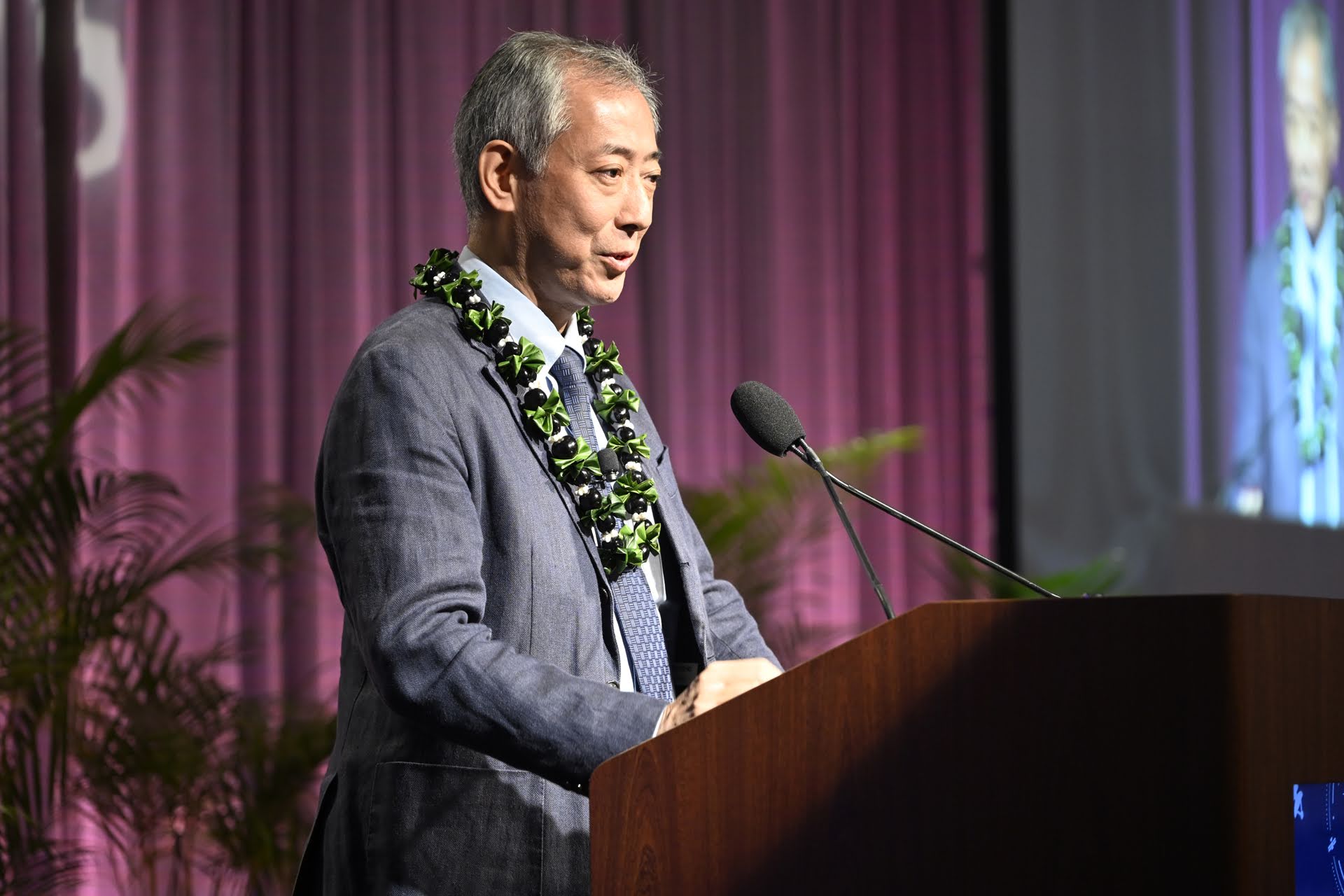
Dr. Hiroshi Yamakawa, President, Japan Aerospace Exploration Agency (JAXA) speaks on Day 2 of AMOS 2024
Victoria Samson, Washington Office Director for Secure World Foundation (SWF) led the SSA Policy Forum on Day 2, SSA in the Asia-Pacific: Where We Are, Where We Are Going. Samson was joined onstage by Dr. Melrose Brown, Acting Director, UNSW Canberra Space; Dan Ceperley, Founder & Chief Operating Officer, LeoLabs; Sittiporn Channumsin, Director of Space Technology Research Center, GISTDA (Geo-Informatics and Space Technology Development Agency); and Lexie Weikert, Manager Business Development, National Security, Astroscale.
Samson started off saying, “It really came home to us that there is a variety of actors and different capabilities. There are emerging space countries; established space powers; a burgeoning new space sector, there are legacy space companies; and just a variety of needs that they have both in terms of using space for development; for active debris removal; and for counter space capabilities, and with that comes just a wide variety of SSA needs and challenges.”
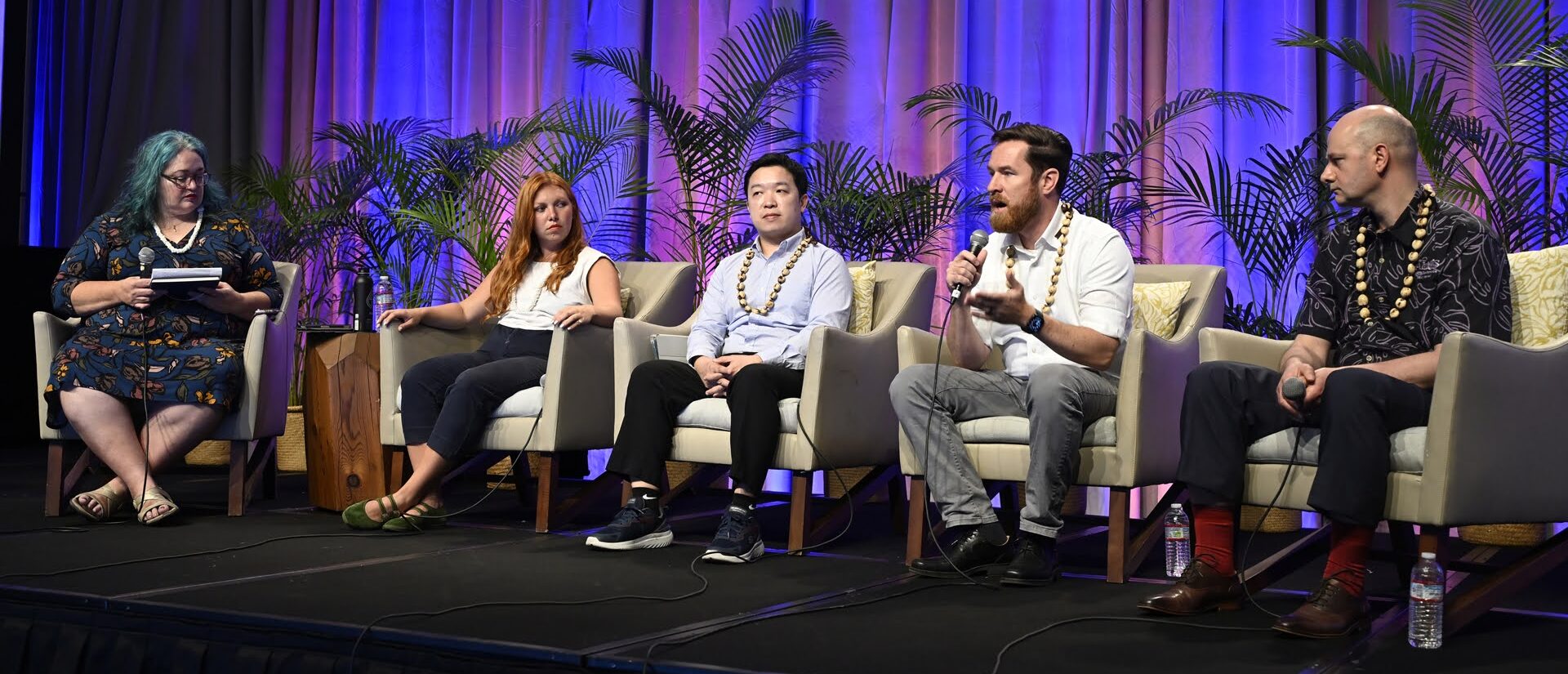
L to R. Victoria Samson, Secure World Foundation; Lexie Weikert, Astroscale; Sittiporn Channumsin, Director of Space Technology Research Center, GISTDA; Dan Ceperley, LeoLabs; Melrose Brown, UNSW Canberra Space
“In Thailand, we have four key measures,” said Sittiporn Channumsin. “The first one we need the tracking and monitoring system. That is, you need basic infrastructure to track and monitor. And next is the analytical tool. For example, you need to position the analysis about the potential correction or leak assessment. And next is the cooperation to make the protocol and framework. And the last one is the system. When we know the protocol and framework, we can set the system—how we share the data among the operators. This is very important.”
Melrose Brown commented, “The things that are specific to Australia that make us a little bit different from some of the countries in the region, we’re just getting into the launch game. So hopefully you’ll see launches from Australia quite soon. We’re also rapidly growing our space capability. Skycraft, that’s a spin out company from us that is going to launch a constellation of satellites to perform air traffic control globally, so that will be up to 200 satellites or so will be launched. Our needs are going to change rapidly, and we need to respond appropriately. Likewise in the defense sphere, we’ve got very important geography that we need to use, and we see a number of very large acquisitions that have either been made or will be or will be coming down.”
“I think what we really need to work on is the use of that SSA data,” concluded Brown. “You can have as much of the observations as you want, but if you don’t have a well-trained end-user base that can use to make really good decisions, then you’re only really working on one part of the problem.”
Dan Ceperley built on the comments saying, “One of the interesting things I think we’ve noticed in the space safety world is the merging of space traffic management and space domain awareness. Interestingly, nowadays, if you want excellent space traffic safety, you need excellent space domain awareness. Back when we started in 2016, the two topics were kind of splitting. For the first time ever, there was new infrastructure that could be solely focused on space safety and could separate away from the defense infrastructure that could allow that to fully focus on the defense mission. But more recently, we’re seeing a lot of activities from lots of new launches and re-entries for military missions and also a huge number of proximity operations that are happening at the same altitudes and intersecting orbits as a lot of commercial spacecraft and activities. It’s sort of like new proximity operations technologies, inspection technologies are being developed right in the middle of the highway that commercial hectares are using. It’s this interesting sort of recombination of two topics that I think may change the forward trajectory of the industry of it.”
Lexie Graham added, “The Asia-Pacific is a very important theater that we recognize and really propel and push for the cooperation of data sharing to ensure the safety of that explicit region. But as you were saying as well, by the nature of what Astroscale does in on-orbit servicing, we do require very niche and exquisite SSA capabilities, both from the ground with our operations, but definitely also in space to perform safe and efficient rendezvous and proximity operations and docking. The need for SSA on our own spacecraft and our own volition is definitely key.”
Day 3
Pam Melroy, Deputy Administrator, NASA, provided the keynote on Day 3 and started off with a response to the underlying theme of the conference with a sense of place. “I’d like to first acknowledge the native Hawaiian community who are the traditional custodians of the land on which we stand and offer my heartfelt condolences on the effects that the wildfires have had on this island and this community. We care a lot about that and we’re doing a lot to try to help with wildfires, but I know that the impact has been intense.”
Melroy spoke about the history of NASA in space sustainability and how they got where they are and some very important steps they are taking going forward. She also went on to give a few broad reflections as a policymaker and a leader on some of the technical challenges facing our community.
After her presentation, asked about the idea of kuleana (sense of responsibility), Melroy said about NASA, “I love this word kuleana. We do talk about what is the purpose of space and going to space and operating through space, and we talk about how it benefits humanity in three ways. The first way is we do unique science in space, science that literally cannot be done from the surface of the earth. One of the most important aspects is that we study the Earth as a planet. We have a unique capability to do that from space.”

Pam Melroy, NASA gave the keynote on Day 3 of AMOS 2024
The third and final SSA Policy Forum was moderated by Krystal Azelton, Senior Director, Program Planning, Secure World Foundation (SWF), discussing Space Weather and SSA—What’s Needed Next. Azelton said, “What we really want to look at in this session is current space weather prediction capabilities, what our practices are for atmospheric density modeling, and then what is the impact that both of these things have on the accuracy of SSA and conjunction warning.”
Panelists joining the discussion were Marco Concha, Flight Dynamics Lead, Amazon Kuiper; Tzu-Wei Fang, Space Scientist, NOAA Space Weather Prediction Center; Piyush Mehta, Associate Professor, West Virginia University; and Matthew Shouppe, Senior Associate, Commercial Space Strategy, Booz Allen Hamilton.

L to R. Krystal Azelton, Secure World Foundation; Marco Concha, Amazon Kuiper; Tzu-Wei Fang, NOAA Space Weather Prediction Center; Piyush Mehta, West Virginia University; and Matthew Shouppe, Booz Allen Hamilton.
Tzu-Wei Fang said, “How we make sure everybody has a common ground unified neutral density model to be utilizing for SSA conjunction analysis is something we are pushing very hard. In terms of forecast, we have lots of gap due to lack of data. We have only a couple of spacecraft that are operationalized in real time between sun and the earth—so pretty much blind if one died in doing any event. So with lack of data, gaps in predicting the solar event to the earth, we don’t have a good way. We actually have tools, but we have low confidence on the storm arrival time. I almost cannot tell you the magnitude of the storm when it comes tomorrow. I think there are a lot of limitations that I want the community to really understand and advocate for us to how we can do a better job in the future. Our next step is producing a probability forecast instead of a deterministic forecast that is probably always wrong.”
Piyush Mehta raised the point about consistent operations. “Historically the way DoD ran things is they did their own analysis and once CDM’s are put out to the operators, they conduct their own analysis, they don’t always match because they’re using different models in the background, different algorithms in the background. The DoD might suggest that there is a close event, but when an operator does its own analysis, they may not see the same thing at all—so it might be an apple to orange comparison. This idea of consistent operations where everybody uses the same set of models and algorithms, I think is another limitation that we need to address.”
Marco Concha announced Amazon Kuiper’s plans to launch many satellites in the future—3,236 eventually. He shared, “There’s a bit of a fog of war when there’s a big storm. It’s not uncommon for an operator to lose contact and a pass will be lost. I don’t know how much situation awareness everyone else has, but people don’t talk about when they lose the spacecraft for a day or two. Imagine that at scale. When we saw the Starlink issue with the very, very large storm, we started paying attention to—will that happen to us? We folded in some of the Initial prototype models that Piyush Mehta has been working with into an analysis set. And we have come up with a pretty good standard to say, if the space weather is this high as it’s measured, based on this model, we probably shouldn’t launch certain parts of the day. And we think that’s really valuable. Long term, though, however, reducing that fog of war is going to help coordinated activities of thousands and thousands of satellites.”
Matthew Shouppe was asked to give a slightly broader commercial perspective, explaining the model discussed by the other presenters, “HASDM (High accuracy satellite drag model) is an entirely different type of drag model compared to more standard drag models that if you are a satellite operator or commercial SSA company in your flight dynamics ground segment, when you have your modeling and simulation, your orbit propagation software, the drag models in basically all those software that I know of, they only take in data from the sun to update the atmospheric model. HASDM takes that, plus, it takes direct measurements of atmospheric density values, just from tracking satellites in space and fitting orbits, if you know enough properties about the satellite. It kind of combines two things in one, and that’s why it’s been so unique over this period of time. Now, the question is, can we have a publicly available or a commercial version equivalent of that? And I think that’s a huge area where—and I’ll expand to—I would say it’s broader than just commercial. It could be commercial companies, academic institutions, research, you know, civil government as well. We just want something that’s available, kind of in mass, that’s accessible to the community.”
Featured Presentations
The 2024 AMOS program included four featured presentations. Wednesday featured a joint talk on Space Logistics Drives SDA by Colonel Jeremy A. Raley, Director, Space Vehicles Directorate, Air Force Research Laboratory and Colonel Joseph J. Roth, Director Innovation & Prototyping Acquisition Delta and Commander, Space Systems Command Detachment 1, U.S. Space Force.
The duo talked about the evolution of refueling technologies from aerial refueling to its influence on on-orbit refueling. “We’re not going to be single step to gas stations in space. We’re trying to figure out what are the most important things to do first and then allow ourselves to understand what are the requirements that are going to drive us as we do that going forward so that we can cross that line there and start to get to a place where it’s fairly normalized.”
Asked to project to the future, Col. Raley said, “I think it’s going to be a lot more about identifying sources of mass and energy that can be used to fuel our exploration, to fuel our military operations, to fuel our commercial operations as we’re up there. And that’s going to drive even more dramatic maneuvers because people will be potentially leaving the earth moon System or coming back and forth to various places like that.”
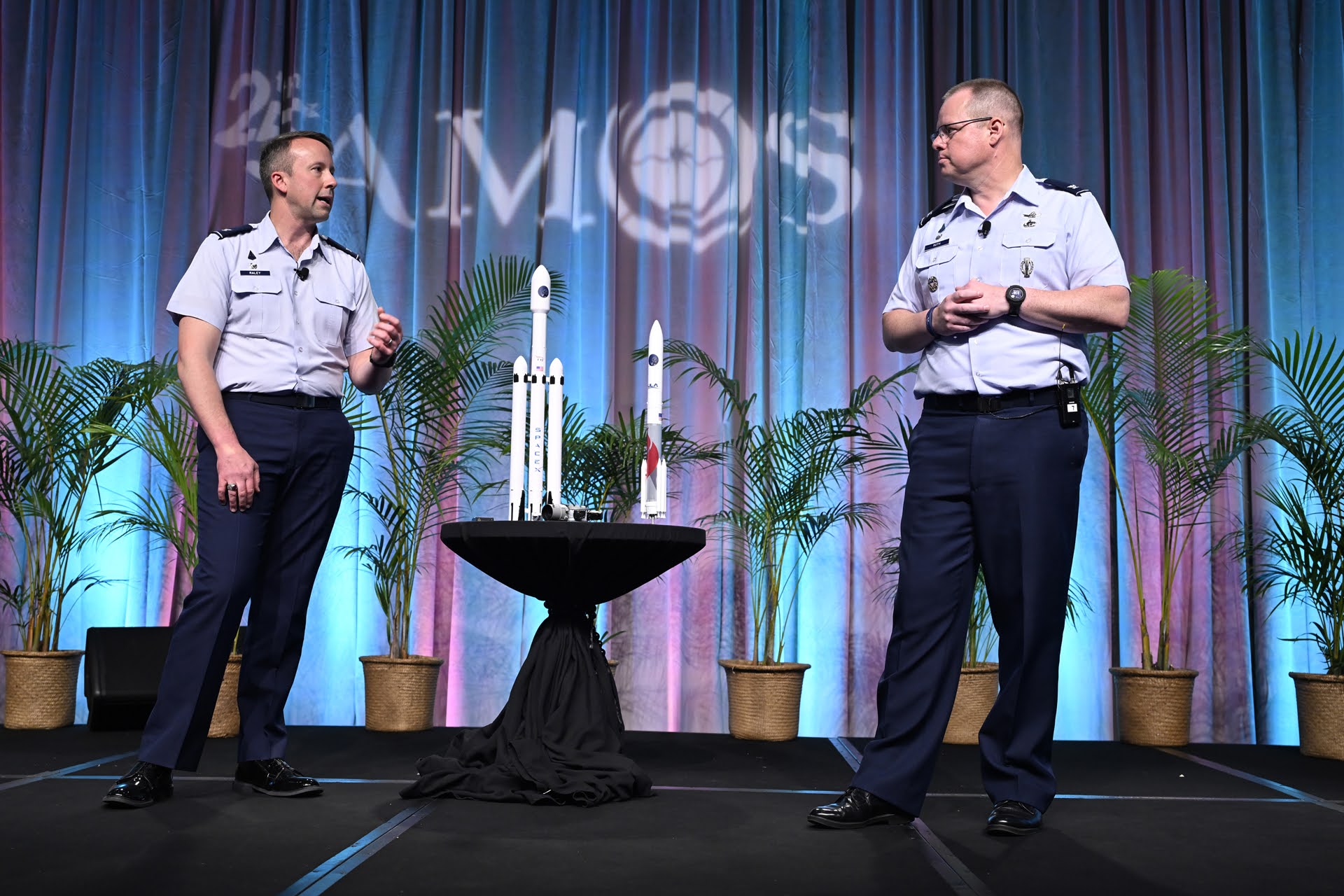
Col. Jeremy A. Raley, AFRL and Col. Joseph Roth, U.S. Space Force speak at AMOS 2024
On Thursday, Lieutenant Colonel Jason Altenhofen, USSF Space Systems Command; and Gregory Less, Millennium Space Systems spoke on Victus Nox: Tactically Responsive Space—Space Domain Awareness Mission.
“The take-away from this mission—is really designed to move with speed. And not just the launch piece, although that kind of gets focused, right? But also from mission concepts, the acquisition, the build of the satellite, getting everything ready and tested, integrated, all the training and rehearsals that we had to do, to logistics of getting to the launch site, to the launch, and to the on-orbit operations. A lot was crammed into a very short period of time. That’s really what Victus Nox was about.”

Richard Dalballo gave a feataured presentation on Day 3 of AMOS 2024
Richard DalBello, Director, Office of Space Commerce took to the stage Friday morning to speak on Updates on the Traffic Coordination System for Space (TraCSS). DalBello reported, “We have data sources, which we’ll be getting the DoD high accuracy catalog. We’ll be augmenting that with commercial, we’ll also be getting space weather data and eventually data from other SSA Providers. That data goes into a big database, we call TraCSS Oasis. On top of that sits the applications that will do the orbital determination and conjunction assessment functions. We also plan—we haven’t got the R&D element fully up to speed yet, but there will be a component called TraCSS Horizon which will create both a development and test environment for us so that we can try out new things before we implement them. It will also be a research environment where academicians and other interested people can try out new ideas in the TraCSS. And then eventually that, of course, gets depicted in the presentation layer. We’ll go out and supply the relevant information to the owner operators and to other stakeholders.”
DalBello explained, “This is an agile development process. And in agile development, you start out with the minimum viable product or MVP. That’s what we’ll be turning on this month. And then what you do is you add capability to the system over time. So over 2025, we’ll be adding the presentation layer.”
On Friday afternoon, Barbara Golf, USSF, Strategic Advisor for SDA, SSC/SZ gave a featured presentation on Joint Commercial Operations (JCO) Introduction and Way Forward.
“The JCO is a Space Domain Awareness cell that we have had in operations for several years now augmenting military space surveillance. We originally focused on protect and defend, feeding into the national space defense center, but we have moved well beyond that,” added Golf.
Later in the presentation Golf explained, “28 nations are part of the JCO, 18 of them, participate in some shape, form, or fashion in operations, but it does look like a mini-UN. Join us! I have teams that help onboard nations or partners into operations. We will ask you what your goals and objectives are, and it’s okay to say, ‘I don’t know.’ This is a ‘choose your own adventure,’ and it can be a meandering adventure when you’re rolling in here. Every nation has been different. Every partner has been different. There is no standard way of doing this.”
Networking
In-person attendees of the annual AMOS Conference have access to numerous networking opportunities with breakfast and lunch included and nightly receptions.
On Wednesday evening the Women and Allies in Space Domain Awareness reception was held for the third year. Sandra Magnus, Chief Engineer for the Traffic Coordination System for Space in the Office of Space Commerce, was the guest speaker at the reception aimed to strengthen and empower the community of women Space Domain Awareness professionals, as well as heighten the understanding of gender disparity within space-related careers.
The exhibit and poster venue was a draw for attendees throughout the conference with exhibiting sponsors demonstrating their products and services. Exhibiting sponsors were: a.i. solutions, Advanced Scientific Concepts, Astro Haven Enterprises, BAE Systems, Celestron, Charles River Analytics, COMSPOC, General Atomics Electromagnetic Systems, GEOST, GMV, Hart Scientific Consulting International, JHU Applied Physics Laboratory, Kayhan Space, KBR, Kratos, LeoLabs, Lipoa Investments, LLC, LSAS Tec, Mitre, Planewave Instruments, Rocket Communications, SAIC, Sea West Observatories, SEAKR, Slingshot Aerospace, SpaceMap, SpaceNav, TOPTICA Photonics and TransAstra.
Sponsoring, but not exhibiting, were Advanced Space, Anduril, Astroscale, BlueHalo, Booz Allan, CACI, EO Solutions, ExoAnalytic Solutions, General Dyamics Mission System, Hawaii Technology Development Corporation, L3 Harris, LinQuest Corporation, Lockheed Martin, Maxar, MDA Space, NEC Aerospace Systems, Northrop Grumman, Peraton, Pier-Tech Inc., Raytheon, Sandia National Lab, SpaceFlux, SpaceX, The Boeing Company, The Tech7 Company and USRA.
“The 25th edition of AMOS has been the most productive conference for us yet,” said Michael Hart of Hart Scientific Consulting International. “We’ve had a lot of very constructive, useful meetings, and it’s been a bit of a challenge trying to squeeze in some of some of the fascinating technical talks in between those meetings.”
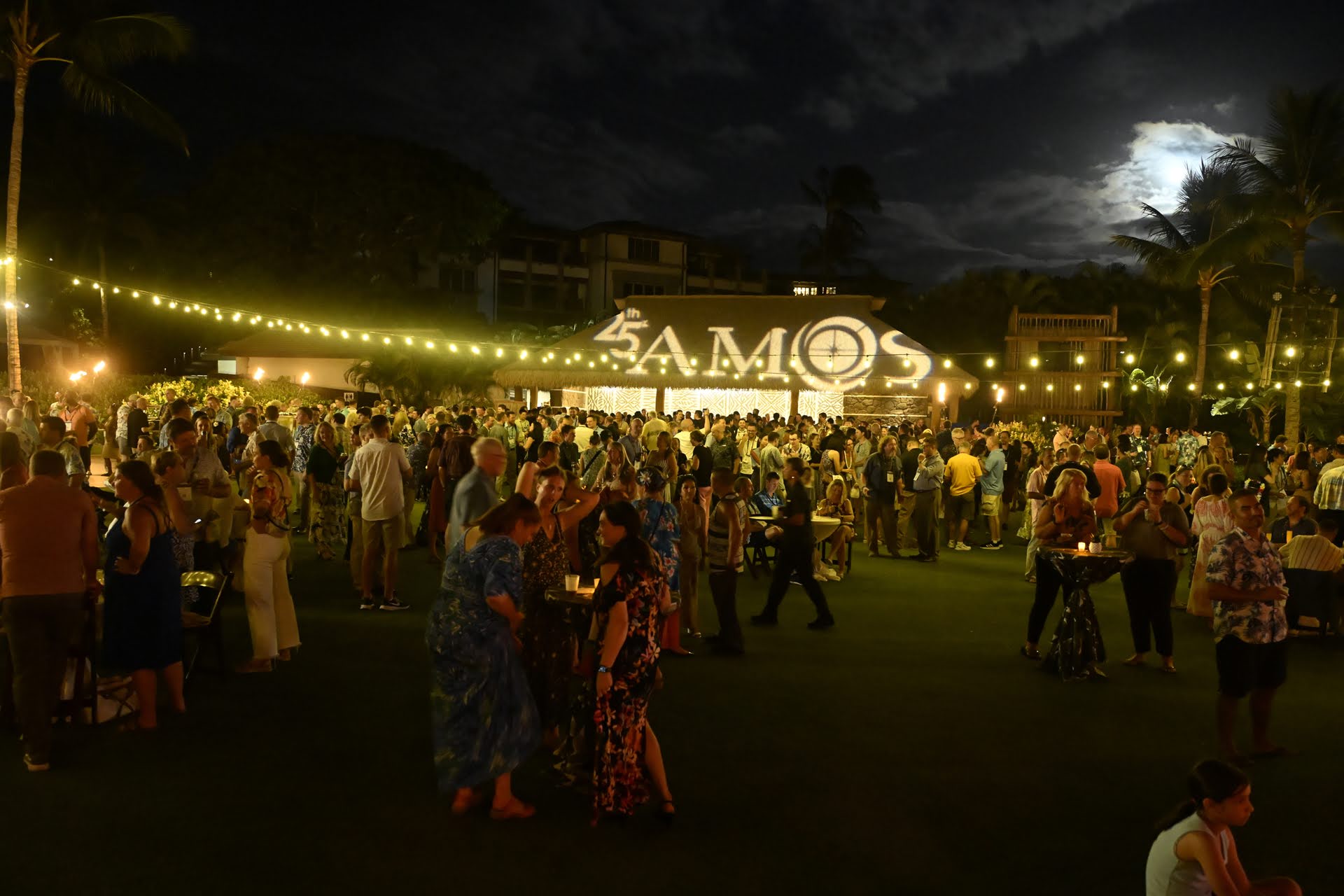
Welcome Reception AMOS 2024
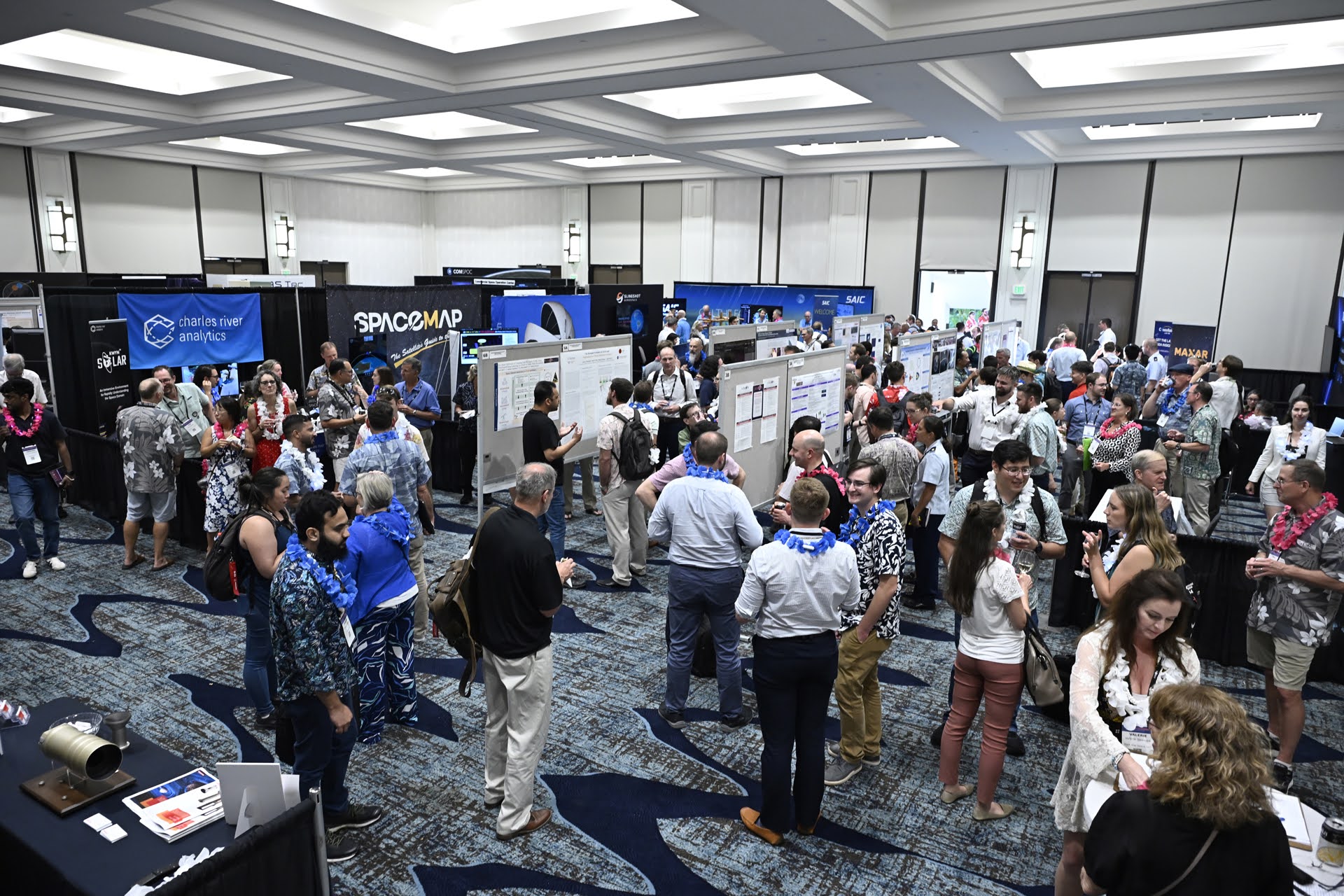
Exhibit & Poster Venue AMOS 2024

Sandy Magnus speaks at Women & Allies in SDA reception at AMOS 2024
EMER-GEN® Program
The 7th EMER-GEN® program for young professionals enthusiastic about careers in space was held in the preceding days of AMOS. A joint initiative of the AMOS Conference and Space Generation Advisory Council (SGAC), the program featured professional development sessions designed to enhance the young professionals’ effectiveness in a global environment.
The main two-day EMER-GEN program featured guest speakers, A Policy Game (for consensus building skills), speed mentoring and an Innovation Challenge. Doug Loverro, Loverro Consulting, returned as a guest speaker working with the young professionals to determine what the top three space-related priorities should be for the next U.S. administration.
For the innovation challenge, delegates worked in teams to design innovative ways to benefit from the approach of Apophis, an asteroid coming close to earth in 2029.
“My favorite part of the program was the innovation challenges because not only was it a great team exercise, but it was also a great activity that gave me perspective into the importance of policies,” said Howin Ma, a student at University of Hawaii at Manoa. “As a mechanical engineer student, I am often more focused on the technical and design aspects to ensure mission success, and very few emphases are placed on the potential consequences to the contribution in space debris. Learning about policy helps to become more aware of the problem and develop a mindset for finding solutions rather than contributing to the problem.”
“I was looking forward to the mentoring session,” said Kanade Karuyama of SYE Perfect JSAT Corporation. “I had a good experience networking with a lot of people and the innovation challenge was really exciting.” Read more about the EMER-GEN experience.
Student Space Exploration Day
After her keynote on Friday, Pam Melroy proceeded to meet with, and speak to, 120 middle school students as part of Space Exploration Day. The students were enthralled by Melroy’s journey as an astronaut and beyond. Before joining the student Melroy touched on inspiration. “In a few minutes, I’m going to talk to some of the students here from Maui, and I’m excited about that. They keep this virtuous cycle of learning and science and building technical capabilities. Space just has a magic way of inspiring people and inspiring students to go into STEM.”
“I want them to be excited about what space has to benefit people here on Earth and to be inspired by that and fascinated by it and then I hope that in me looking at me they can go well if she could do it I could do it too,” Melroy concluded.
“I feel like it’s really inspiring being, especially a woman, during that time, because most women were always told to downplay what they want to be and their dreams and hopes,” said Leanne Bylay, seventh grade at Maui Waena Intermediate School. “My biggest takeaway was that everyone has a role, no matter if it’s a smaller role or a bigger role, it still plays a role in the end.”
After the talk, the students then participated in hands-on, space-related activities with select AMOS exhibitors and local organizations.
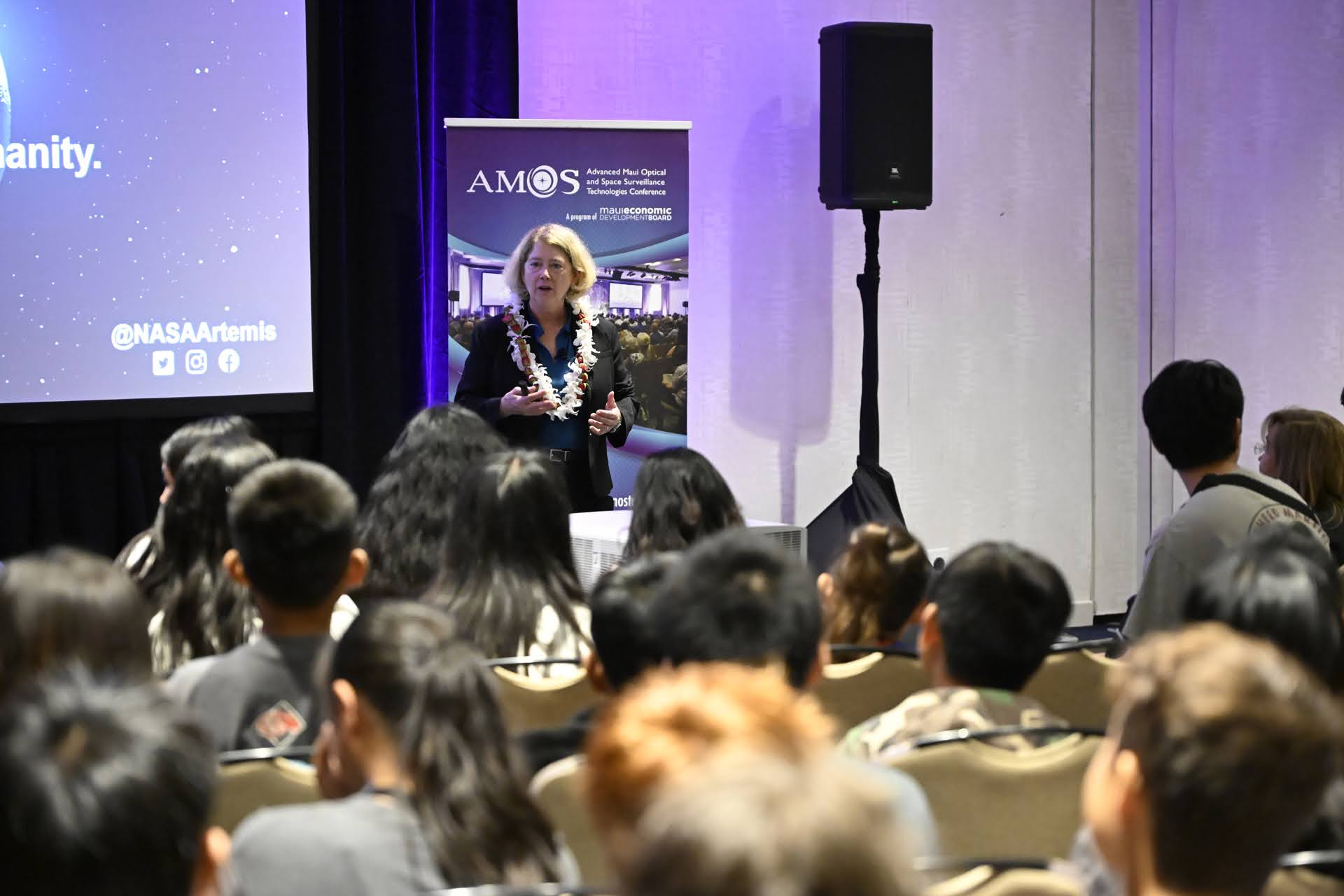
Pam Melroy, NASA, spoke to middle school students for Student Space Exploration Day at AMOS 2024

Middle school students participated in activities in the exhibit venue at AMOS 2024
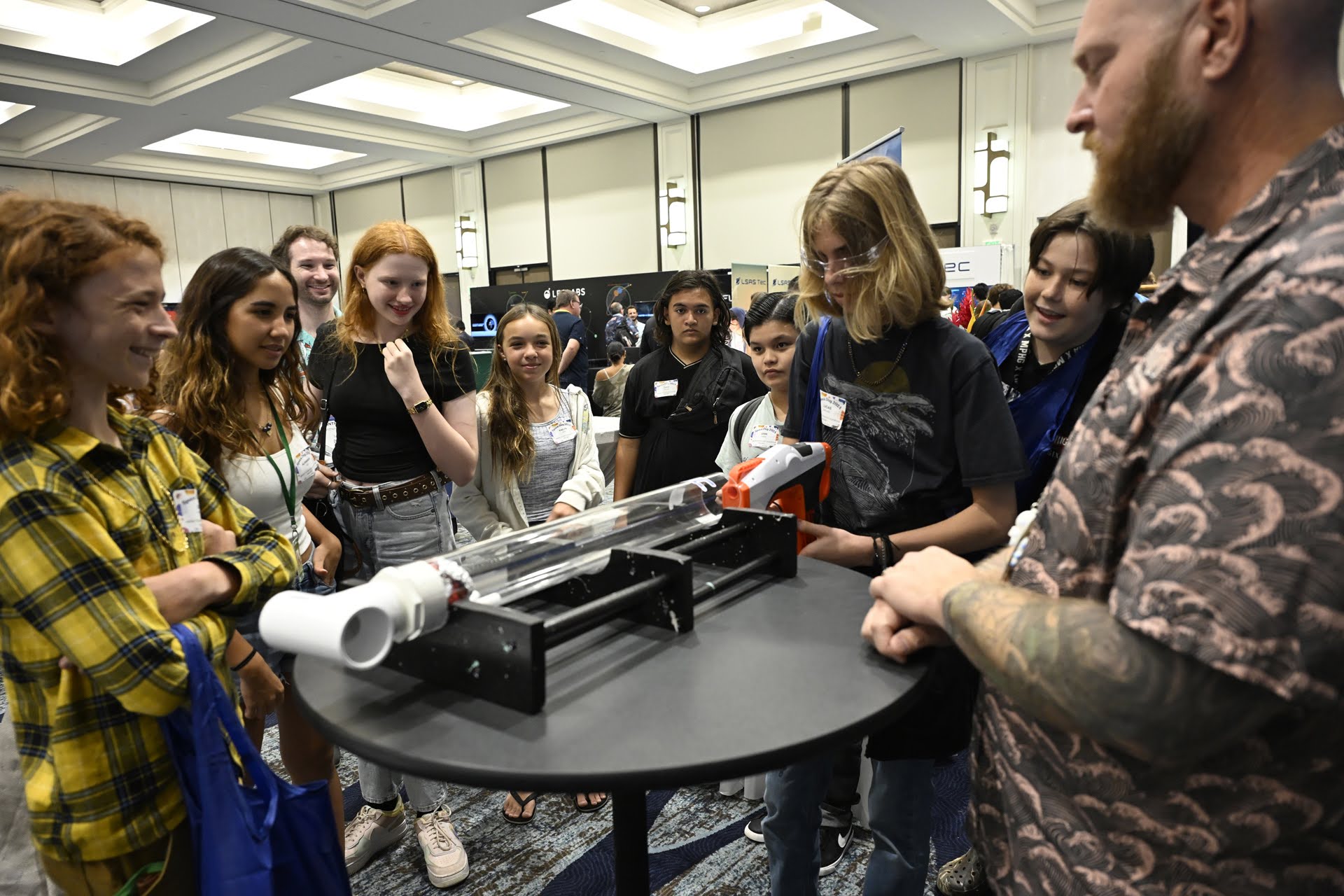
Select exhibitors inspired students with space related activies during AMOS 2024
Summary
“I came first time in, I think, 2018 or 2017,” said Keith Toner of MITRE. “It was this wonderful moment of I came from space launch in the 90s and then had a long period of time away from space and in three days I was able to catch up and refresh on the state of the art at the time and connect with people that I hadn’t seen in a long time and understand the world differently in space capabilities than we had seen before. It’s this great opportunity to have like a 101, 201, 301 course levels in three days that you just don’t get elsewhere particularly around Space Traffic Management.”
Asked about the conference being on Maui, Toner added, “It’s an infectious place with a spectacular culture of welcoming, the Aloha Spirit. But to be honest with you, I’d come to this conference in Camden, New Jersey. It’s that important. That it’s here makes it a little bit better and allows our foreign friends to make it a little easier jump across the pond from Australia and Japan and others.”
“I’ve been here since I was a graduate student,” said Aaron Rosengren, a professor at USC San Diego and chair of Space Surveillance Committee of the AAS. “When I was a graduate student, when I was one of the emerging people in SSA, I recognized the level of the conference and how much it’s grown tremendously and the technical contributions. It’s become a little bit more industry focused over time, but we still have had a higher output of technical contributions.”
Victoria Samson, Secure World Foundation summed up the experience of collaborating with MEDB on the policy forum, “I think it was a really great example of how the policies for SSA are jsut as well attended as the technical ones and the importance to continue the conversation on all the issues that ensure that we can get the benefits from these in space.”
The AMOS Conference and EMER-GEN are presented by the Maui Economic Development Board, Inc. (MEDB), a nonprofit corporation established in 1982 to focus on diversifying Maui’s economy. MEDB’s mission involves taking innovative actions that strengthen existing industry as well as diversifying through new opportunities. Save the dates for 2025—September 16-19 with EMER-GEN Program on September 14-16.
